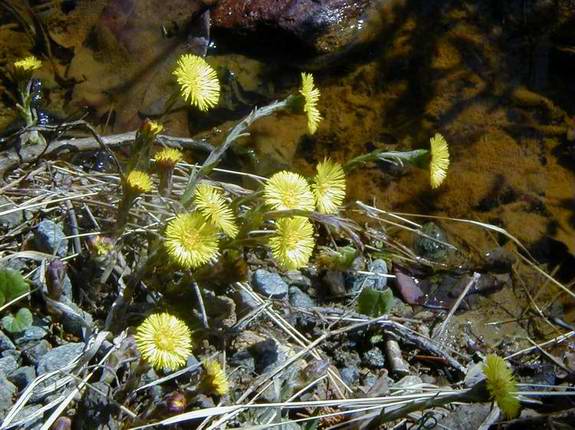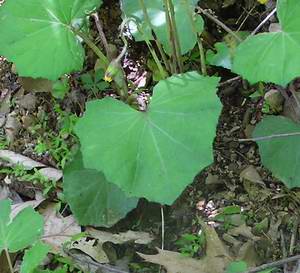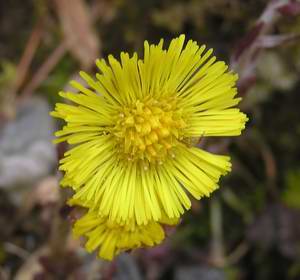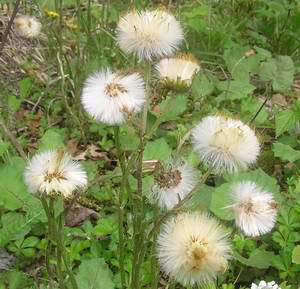|
Return to Hiker's Notebook Home Page
Common Name: Coltsfoot, Ass's Foot, Horsehoof, Fieldhove, Donnhove, Foalswort, Flower velure, Farfara, Coughwort, British Tobacco, Filius ante patrem (Latin), Maть и Maчexa (Russian) - The various common names which employ the term hoof or hove (a variation of hoof) refer to the hoof-like shape of the leaves that appear several months after the flowers have wilted (see picture below).
Scientific Name: Tussilago farfara - The generic name is from the Latin tussio, meaning 'to have a cough' and ago meaning 'to drive' in reference to its historical use "to drive away coughs." The species name farfara literally means 'coltsfoot' in Latin which is why 'farfara' is another common name for coltsfoot. The etymology of the Latin and species name is sometimes ascribed to farfarus, an archaic name for the white poplar tree whose leaves have a lobed margin that is similar to those of coltsfoot.
The coltsfoot is among the first flowers to appear in the spring, blooming
with astral, golden flowers that superficially resemble those of the
dandelion. They are both members of
Asteraceae, the sunflower or daisy family and accordingly have the same
multiple flowers arrayed in a larger composite disk arrangement. However, a
more thorough inspection would reveal the verisimilitude; the coltsfoot has a
plethora of radiating narrow ray flowers surrounding the central disk and a
stalk that is covered with scales whereas the dandelion is comprised of
tube-shaped florets and a smooth stem. As a matter of interest, they are both
named for the shape of their leaves, the equestrian coltsfoot and the leonine
dandelion; dents du lion means 'teeth of the lion' in French. The
colt's foot
Coltsfoot has been used primarily as a cough suppressant but also for a wide range of other ailments throughout history. The Roman Gaius Plinius Secundus (23 CE � August 25, 79), better known as Pliny the Elder, recommended burning coltsfoot leaves on cypress charcoal and drawing the smoke into the mouth with a reed to treat a chronic cough with a sip of wine between draughts to ameliorate the harsh effects of the smoke. The late Renaissance English herbalists also extolled the beneficent properties of coltsfoot. John Gerard published the Herball in 1597 in which he proscribed coltsfoot to "effectually helpeth those that are troubled with the shortnesse of breath and fetch their winde thicke and often." Nicolas Culpeper's 1653 Complete Herbal also recommended it as a "singularly good remedy against all agues � which also does much good being applied to any hot swelling or inflammations. It helpeth St. Anthony's fire (erysipelas) and burnings and is singular good to take away wheals." A smoking mixture still promoted as British Herb Tobacco is their legacy. Comprised primarily of coltsfoot with other herbs including betony, rosemary, thyme and lavender, it is smoked as a treatment for asthma, catarrh and other lung ailments, supposedly with none of the harmful effects of tobacco. The coltsfoot was such a well known herbal remedy in France that Parisian apothecaries were indicated by a depiction of a coltsfoot flower on their doorposts. It is likely that the importation of T. farfara to North America from its native Eurasia was an intentional act of early colonists to take advantage of its known medicinal properties. One of the colonial treatments for whooping cough was to wrap the afflicted in coltsfoot infused blankets.
The curative properties of coltsfoot have been validated by modern analytical methods that have isolated its constituent compounds as polysaccharide mucilage, flavonoids, pyrrolizidine alkaloids, tannin, ascorbic acid and zinc. The mucilage acts as an anti-inflammatory to soothe the throat and as an expectorant to clear excess phlegm. The flavonoids act in concert as an anti-spasmodic treatment to suppress the convulsive contractions that manifest as a cough. To this end, a cough syrup decoction can be made with one ounce of leaves or flowers added to a quart of water that is then boiled down to a pint with honey added as an electuary. There is an iatrogenic side to coltsfoot medications, however. The pyrrolizidine alkaloids senecionine and senkirkine are hepatotoxic according to a Japanese study that found cancerous tumors in the livers of rats when fed a diet with high alkaloid concentrations (over 4%). Since coltsfoot contains very low concentrations (0.015%) and since the volatile alkaloids would be eliminated by boiling, concerns as to the toxicity of coltsfoot are probably exaggerated.
|

 shaped leaves appear about a month after the flowers have long since wilted
and gone to seed. To the vast majority of inattentive observers, the leaves
are not even associated with the same plant and are often vilified for their
obtrusion into croplands, a doppelg�nger to the salubrious blossoms they
supplant. The Latin common name Filius ante patrem meaning
'son-before-the-father' is attributable to the dissociate growth pattern.
Coltsfoot can blossom in early March due to cold-tolerant adaptations that
are attendant to its vernal seasonal transition: The scabrous stem insulates
the vascular system against freezing; The composite flower heads remain
tightly closed against the hibernal elements during dark and overcast
conditions, opening only in tropism; The leaves are covered with downy hairs
when they first emerge to insulate against freezing. The down on the upper
leaf sloughs off as ambient temperature rises, though a coating of fine hair
is retained on the lower surface to protect the stomata from obtrusion.
Because of this the dorsal side of the leaf is cooler than the hairy ventral
side. In Russian the coltsfoot is called Maть и Maчexa which means 'mother
and stepmother' which characterizes this temperature difference, the mother is
the warm side of the leaf and the mother-in-law is the cold side of the leaf,
a metaphor of their caricatures. The alternative name 'flower velure' also
refers to the fine hair on the lower side of the leaf (velure is French for
velour, a velvet-like fabric), which was once collected by English peasants
for use as tinder.
shaped leaves appear about a month after the flowers have long since wilted
and gone to seed. To the vast majority of inattentive observers, the leaves
are not even associated with the same plant and are often vilified for their
obtrusion into croplands, a doppelg�nger to the salubrious blossoms they
supplant. The Latin common name Filius ante patrem meaning
'son-before-the-father' is attributable to the dissociate growth pattern.
Coltsfoot can blossom in early March due to cold-tolerant adaptations that
are attendant to its vernal seasonal transition: The scabrous stem insulates
the vascular system against freezing; The composite flower heads remain
tightly closed against the hibernal elements during dark and overcast
conditions, opening only in tropism; The leaves are covered with downy hairs
when they first emerge to insulate against freezing. The down on the upper
leaf sloughs off as ambient temperature rises, though a coating of fine hair
is retained on the lower surface to protect the stomata from obtrusion.
Because of this the dorsal side of the leaf is cooler than the hairy ventral
side. In Russian the coltsfoot is called Maть и Maчexa which means 'mother
and stepmother' which characterizes this temperature difference, the mother is
the warm side of the leaf and the mother-in-law is the cold side of the leaf,
a metaphor of their caricatures. The alternative name 'flower velure' also
refers to the fine hair on the lower side of the leaf (velure is French for
velour, a velvet-like fabric), which was once collected by English peasants
for use as tinder. Since
coltsfoot is among the first to flowers it has scant competition for insect
pollinators and is in fact an important source of nectar for the emergent bee
population. The ray-flower female portion is comprised of the hundreds of
radiating florets around the circumference of the composite flower, the
stigmas are attached at the base of each ray to the "flower head" at the top
of the stem. The disk-flower male florets are in the center of the composite
flower with about forty pollen-producing anthers. Pollination is effectuated
by this arrangement as an insect departing from the male center of one flower
would alight on the female rays of the adjacent flower so that the requisite
pollen is transferred from the stamen of one flower to the stigma of a
different flower in the cycle of induced genetic variation. The practical
arrangement of the male anther and the female stigma to ensure pollinator
fertilization would in and of itself facilitate the spread of coltsfoot; the
fact that it can pollinate itself further increases its chances of
propagation. Self-pollination is effected when the flower head closes, the
male and female florets are thereby compressed to close physical proximity.
The coltsfoot is thus a perfect flower, it can provide for its own
pollination. The result is the creation of a seed for each female floret. The
seeds develop a gauze-like appendage
Since
coltsfoot is among the first to flowers it has scant competition for insect
pollinators and is in fact an important source of nectar for the emergent bee
population. The ray-flower female portion is comprised of the hundreds of
radiating florets around the circumference of the composite flower, the
stigmas are attached at the base of each ray to the "flower head" at the top
of the stem. The disk-flower male florets are in the center of the composite
flower with about forty pollen-producing anthers. Pollination is effectuated
by this arrangement as an insect departing from the male center of one flower
would alight on the female rays of the adjacent flower so that the requisite
pollen is transferred from the stamen of one flower to the stigma of a
different flower in the cycle of induced genetic variation. The practical
arrangement of the male anther and the female stigma to ensure pollinator
fertilization would in and of itself facilitate the spread of coltsfoot; the
fact that it can pollinate itself further increases its chances of
propagation. Self-pollination is effected when the flower head closes, the
male and female florets are thereby compressed to close physical proximity.
The coltsfoot is thus a perfect flower, it can provide for its own
pollination. The result is the creation of a seed for each female floret. The
seeds develop a gauze-like appendage called a pappus that serves to promote wind transport capable of moving the
seeds more than 8 miles away. Scottish Highlanders gathered coltsfoot pappi to
stuff pillows and mattresses. And if this were all not enough, the coltsfoot
grows vegetatively, its roots extend away for the initial flower to promote
the spread of the plant. Coltsfoot is therefore successful because it grows in
nutrient deficient disturbed waste areas like roadsides with arenaceous
(sandy) soils, is highly fecund, produces copious quantities of
wind-distributed seeds and propagates vegetatively so that it is very
difficult to eradicate once established. It is classified as a weed in
Alabama and Oregon and as an invasive plant in Connecticut.
called a pappus that serves to promote wind transport capable of moving the
seeds more than 8 miles away. Scottish Highlanders gathered coltsfoot pappi to
stuff pillows and mattresses. And if this were all not enough, the coltsfoot
grows vegetatively, its roots extend away for the initial flower to promote
the spread of the plant. Coltsfoot is therefore successful because it grows in
nutrient deficient disturbed waste areas like roadsides with arenaceous
(sandy) soils, is highly fecund, produces copious quantities of
wind-distributed seeds and propagates vegetatively so that it is very
difficult to eradicate once established. It is classified as a weed in
Alabama and Oregon and as an invasive plant in Connecticut.